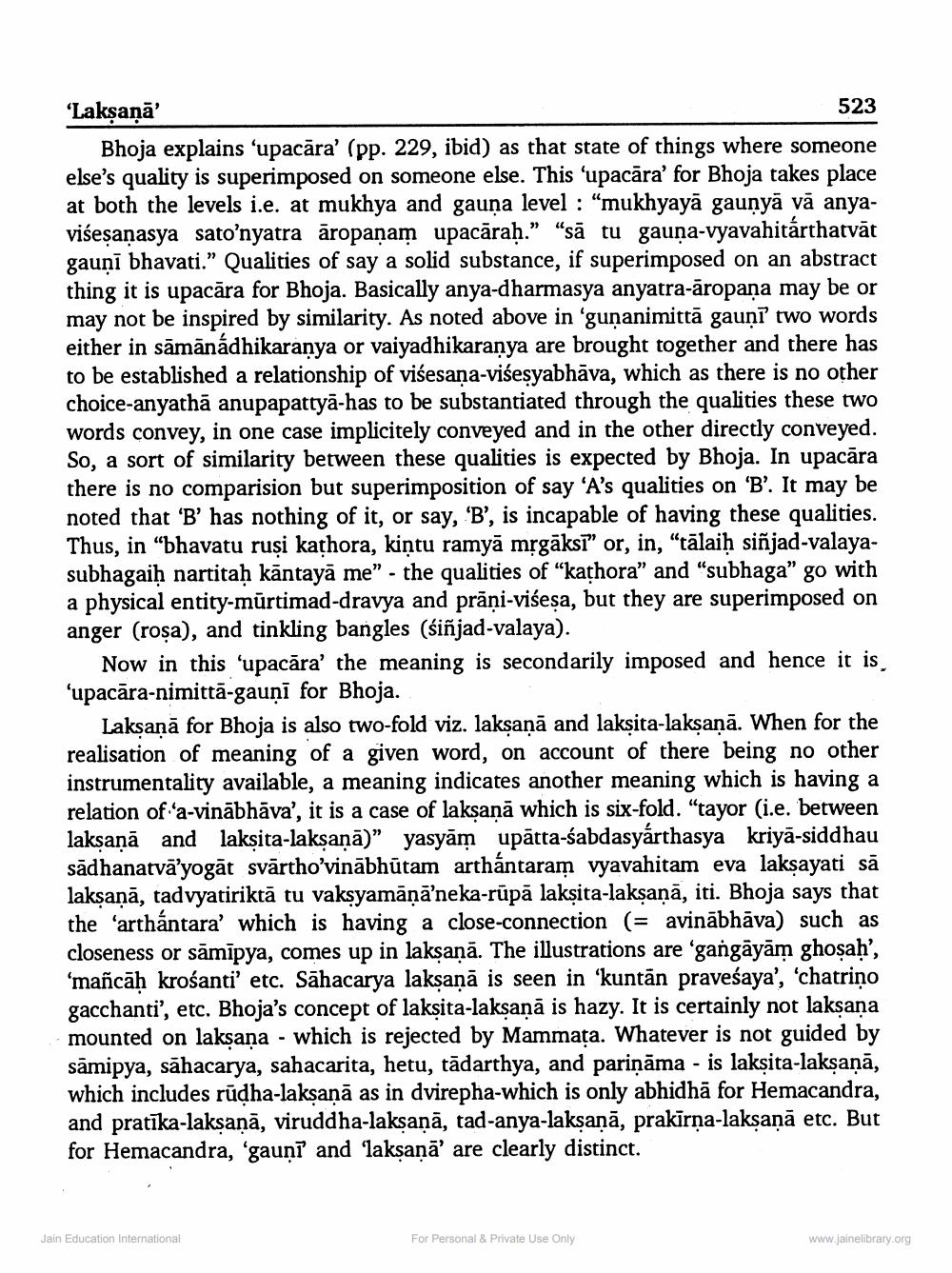________________
‘Lakşaņā
523 Bhoja explains ‘upacāra' (pp. 229, ibid) as that state of things where someone else's quality is superimposed on someone else. This ‘upacara' for Bhoja takes place at both the levels i.e. at mukhya and gauna level : “mukhyayā gaunyā vā anya višesaṇasya sato'nyatra aropanam upacāraḥ.” “sā tu gauņa-vyavahitárthatvāt gauņī bhavati." Qualities of say a solid substance, if superimposed on an abstract thing it is upacāra for Bhoja. Basically anya-dharmasya anyatra-āropaņa may be or may not be inspired by similarity. As noted above in 'gunanimittā gauņī two words either in sāmānádhikaranya or vaiyadhikaranya are brought together and there has to be established a relationship of visesana-viśesyabhāva, which as there is no other choice-anyathā anupapattyā-has to be substantiated through the qualities these two words convey, in one case implicitely conveyed and in the other directly conveyed. So, a sort of similarity between these qualities is expected by Bhoja. In upacāra there is no comparision but superimposition of say 'A's qualities on 'B'. It may be noted that 'B' has nothing of it, or say, 'B', is incapable of having these qualities. Thus, in “bhavatu rusi kathora, kintu ramyā mrgāksī” or, in, "tālaih siñjad-valayasubhagaiḥ nartitah kāntayā me” - the qualities of “kathora” and “subhaga” go with a physical entity-mūrtimad-dravya and prāņi-višesa, but they are superimposed on anger (rosa), and tinkling bangles (śiñjad-valaya).
Now in this 'upacāra’ the meaning is secondarily imposed and hence it is ‘upacāra-nimittā-gauņi for Bhoja.
Laksanā for Bhoja is also two-fold viz. laksana and laksita-laksanā. When for the realisation of meaning of a given word, on account of there being no other instrumentality available, a meaning indicates another meaning which is having a relation of 'a-vinābhāva', it is a case of laksanā which is six-fold. "tayor (i.e. between laksaņā and lakṣita-laksaņā)" yasyām upātta-śabdasyárthasya kriya-siddhau sadhanatvā'yogāt svārtho'vinābhūtam arthántaram vyavahitam eva laksayati sā laksanā, tadvyatiriktā tu vaksyamānā'neka-rūpā lakṣita-laksanā, iti. Bhoja says that the farthántara' which is having a close-connection (= avinābhāva) such as closeness or sāmīpya, comes up in laksanā. The illustrations are 'gangāyām ghoṣaḥ', ‘mañcāḥ krośanti' etc. Sāhacarya laksaņā is seen in ‘kuntān praveśaya', 'chatriņo gacchanti', etc. Bhoja's concept of lakṣita-laksaņā is hazy. It is certainly not laksana mounted on laksana - which is rejected by Mammața. Whatever is not guided by samipya, sāhacarya, sahacarita, hetu, tādarthya, and parināma - is lakṣita-laksaņā, which includes rūdha-laksaņā as in dvirepha-which is only abhidhā for Hemacandra, and pratīka-laksaņā, viruddha-laksaņā, tad-anya-laksanā, prakīrņa-laksaņā etc. But for Hemacandra, 'gaunī and 'laksanā' are clearly distinct.
Jain Education International
For Personal & Private Use Only
www.jainelibrary.org




